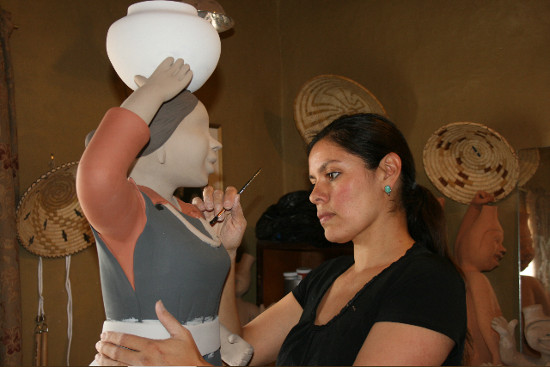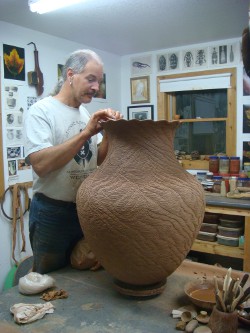
On Wednesday, September 15, and Thursday, September 16, Augustana College will host five of the Native American artists represented in the Olson-Brandelle North American Indian Art Collection, which through October 30 is on display at the Augusta College Art Museum.
"Never before have we brought in five major visual artists at one time," promotional materials for the events state. "The convocation will be an unusual interactive experience - not a lecture you sit for - as groups tour around to see each artist in action. We haven't ever tried an event like this one, and it promises some memorable experiences, including a grand drum and dance finale."
The events are:
Panel Discussion with Artists Represented in the Olson-Brandelle North American Indian Art Collection
Wednesday, September 15, 7:30 p.m., Larson Hall, followed by reception in the Augustana College Art Museum
Participating artists will be: D. Y. Begay, Navajo weaver; Robert Tenorio, Santo Domingo potter; Kathleen Wall, Jemez figurative potter; Richard Zane Smith, Wyandot potter; and Sally Black, Navajo basket maker.
First Connections: An Arts Festival with Artists Demonstrating their Work
Thursday, September 16, 10:30 a.m. to noon, Centennial Hall Convocation
All five artists will participate, along with Navajo basket maker Agnes Gray. The Brown Otter Singers Song & Dance Group (Meskwaki) will provide a finale for this event in Centennial Hall at 11:30 a.m.
A press release for the exhibit follows.
The Augustana College Art Museum will display for the first time in its entirety the Olson-Brandelle North American Indian Art Collection during August 24 through October 30, 2010. This collection introduces Southwest Puebloan ceramics at a level that otherwise can only be studied only in Denver or Indianapolis. Exhibition-related events include an arts festival where artists represented in the collection will demonstrate and speak about their work.
In August 2004, Kent Olson (Augustana '61) and his wife Elaine donated the collection to Augustana, and have supported subsequent additions. The 318 art objects comprise more than 220 traditional Pueblo Indian pottery forms, with the remainder in baskets and other textiles, original prints and clay ?gures. Also included are 36 photogravures by Edward Curtis from his volume The Hopi, and a substantial reference library. Dating from pre-1600 to the present, the collection aims at documenting continuing traditions and the recognition achieved by Native American potters during the 20th century.
 The exhibition and accompanying 336-page catalog are part of the sesquicentennial celebration of the founding of Augustana College. Major scholars wrote catalog essays, including Duane Anderson, Karen Barrie, Bruce Bernstein, Jill Leslie Furst, Francis Harlow and Barton Wright. More than 50 Augustana College students, four faculty, two administrators and the donor were involved in research and writing for the catalog. Museum hours are noon to 4 p.m., Tuesdays through Saturdays. The Augustana College Art Museum is located in Centennial Hall, at the northwest corner of 7th Avenue and 38th Street, Rock Island, Illinois. See the attached page for information on specific special events coordinated with the exhibition.
The exhibition and accompanying 336-page catalog are part of the sesquicentennial celebration of the founding of Augustana College. Major scholars wrote catalog essays, including Duane Anderson, Karen Barrie, Bruce Bernstein, Jill Leslie Furst, Francis Harlow and Barton Wright. More than 50 Augustana College students, four faculty, two administrators and the donor were involved in research and writing for the catalog. Museum hours are noon to 4 p.m., Tuesdays through Saturdays. The Augustana College Art Museum is located in Centennial Hall, at the northwest corner of 7th Avenue and 38th Street, Rock Island, Illinois. See the attached page for information on specific special events coordinated with the exhibition.
The collection is dedicated to honor the donor's family tree of Olsons and Brandelles, all of Swedish American heritage, some of whom attended Augustana College and were active in the Augustana Synod. While Kent Olson's career was that of an attorney, his calling in life has been to connect with Southwest Native American people through collecting their art. His interest began in 1979 while visiting a colleague in Scottsdale, Arizona. In his host's library, he found a book with photographs of pueblo pottery in desert settings, and his search to learn more led to galleries, museums and the famous Indian Market in Santa Fe. During the course of his studies, he developed friendships with scholars and the artists themselves. He realized the importance of family relations in preserving artistic momentum. "Many times an early 20th-century matriarch inspired multiple generations of artists to follow, and to bring new ideas to their heritage," Maurer notes. Thus the Hopi-Tewa potter known only as "Nampeyo" is represented, along with works from her great-granddaughters.
In his collection, Olson aimed for diversity of pueblo, clay, shapes and uses. It was assembled to allow for study of the growth of North American Indian art as a ?ne art form. Most of the objects derive from groups associated with Arizona and New Mexico?although objects from makers in Alaska, California, New York, North Carolina, Oklahoma and Utah are included. The ceramic accomplishments of the Southwest Pueblos are the strongest of North American indigenous groups, reflecting a reliance on the most prominent natural resource of the arid landscape?the earth itself. There are also objects from artists of northern Mexico, particularly those associated with the Casas Grandes ceramics revival that has reflected pottery traditions of the American Southwest.
Augustana College President Steve Bahls has observed, "On this 150th anniversary of the founding of Augustana College, may the Olson-Brandelle collection provide generations of Augustana students a connection to the past and present of an extraordinary culture?in a way that cleanses them of misunderstanding, and opens them to deeper respect of the peoples who came before them on this land we now know as America."
The Augustana College Art Museum is located in Centennial Hall, at the northwest corner of 7th Avenue and 38th Street, Rock Island, Illinois. Museum hours are noon to 4 p.m., Tuesdays through Saturdays.
For more information contact (309)794-7231.










